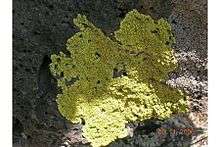Pleopsidium chlorophanum
Pleopsidium chlorophanum (gold cobblestone lichen)[1][2]:27 is a distinctively colored, bright lemon-yellow to chartreuse[3] crustose lichen, which favors dry arctic or alpine sandstone cliffs and boulders. It's a rare alpine lichen in Europe. It is in the Pleopsidium genus of the Acarosporaceae family.
| Pleopsidium chlorophanum | |
|---|---|
 | |
| Scientific classification | |
| Kingdom: | |
| Division: | |
| Class: | |
| Order: | |
| Family: | |
| Genus: | |
| Species: | P. chlorophanum |
| Binomial name | |
| Pleopsidium chlorophanum | |
This lichen is one of the few species able to survive at high altitudes in Antarctica, at altitudes of up to 2000 meters. It is able to cope with high UV, low temperatures and dryness. In its Antarctic habitat, it can be found on the surface, but it's mainly found in cracks, where just a small amount of scattered light reaches it. This is probably adaptive behaviour to protect it from UV light and desiccation. It remains metabolically active in temperatures down to -20 C, and can absorb small amounts of liquid water in an environment with ice and snow.
It is of especial interest for astrobiology since this is one of the most Mars like environments on the Earth. In a 34-day experiment when placed in a Mars simulation chamber, it continued to photosynthesize, and it adapted to Mars conditions and even adapted physiologically by increasing its photosynthetic activity, and producing new growth.[4]
It is similar to Acarospora schleicheri, which grows on soil (terricolous lichen) and rarely on rock, and to Pleopsidium flavum.[5]:186 that grows in high elevations (montane to alpine) on vertical or overhanging hard felsic rock (e.g. granite) in western North America.[5]:186
Its thallus grows in a circular outwardly radiating pattern (crustose placoidioid), with 1mm wide lobed edges.[5]:186 It differs from Pleopsidium flavum in having a smooth, smaller squamulose thallus and larger apothecia (spore producing structures)[1]
References
- "Pleopsidium chlorophanum". Encyclopedia of Life.
- The Laws Field Guide to the Sierra Nevada, John Muir Laws , 2007
- Crustose Rock Lichens, Wayne P. Armstrong, Wayne's World online textbook of natural history,
- de Vera, Jean-Pierre; Schulze-Makuch, Dirk; Khan, Afshin; Lorek, Andreas; Koncz, Alexander; Möhlmann, Diedrich; Spohn, Tilman (2014). "Adaptation of an Antarctic lichen to Martian niche conditions can occur within 34 days" (PDF). Planetary and Space Science. 98: 182–190. doi:10.1016/j.pss.2013.07.014. ISSN 0032-0633.
- Mosses Lichens & Ferns of Northwest North America, Dale H. Vitt, Janet E. marsh, Robin B. Bovey, Lone Pine Publishing Company, ISBN 0-295-96666-1